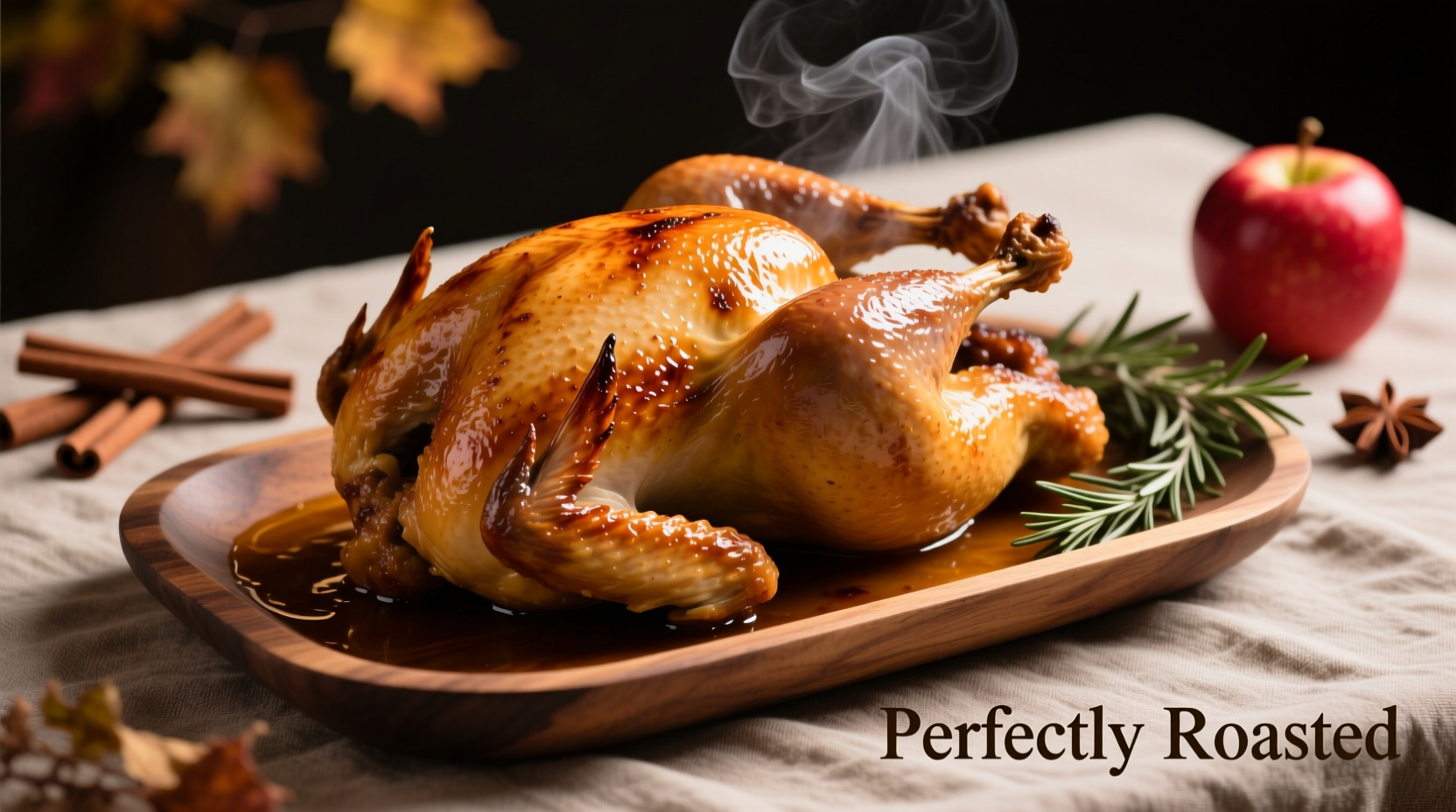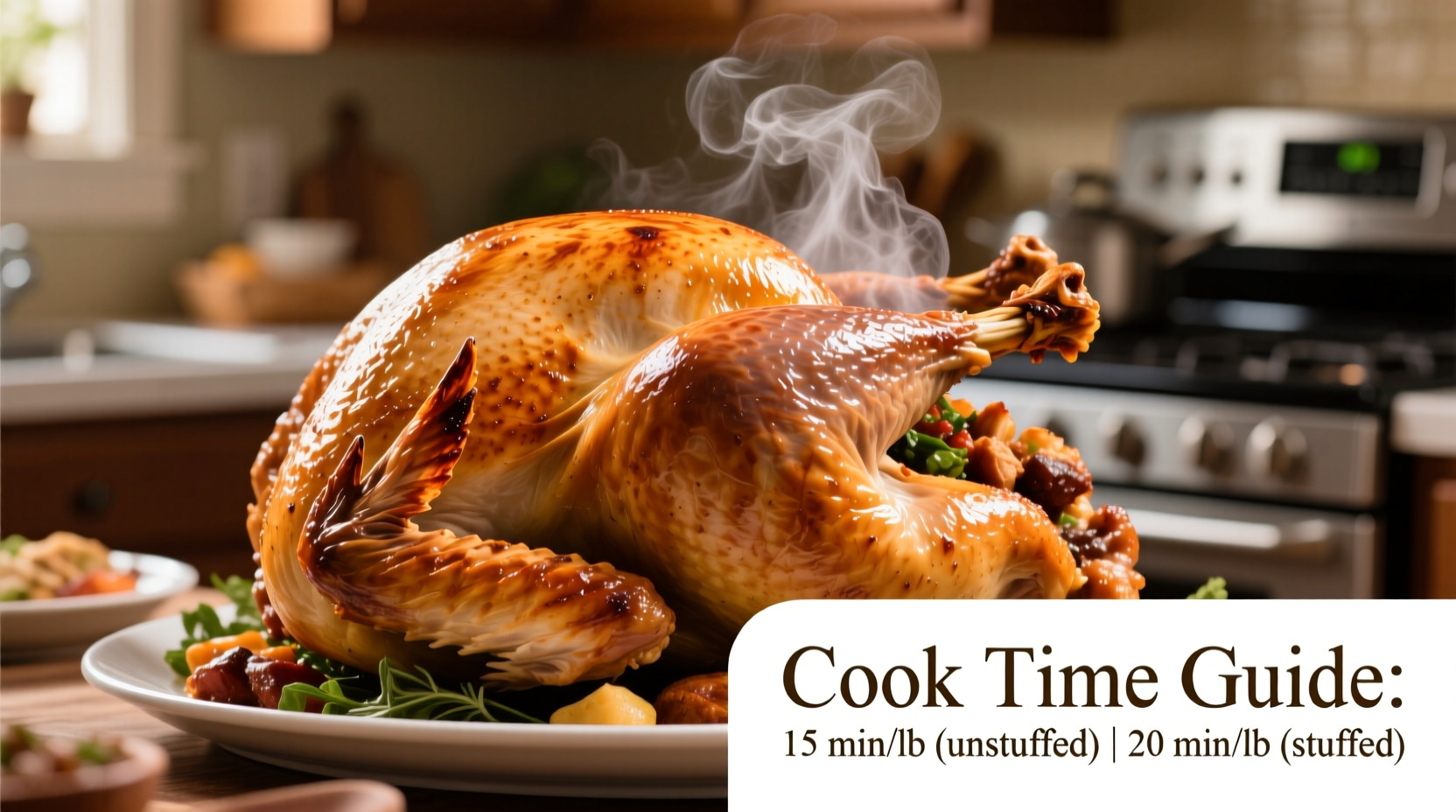Planning your holiday centerpiece? Getting turkey cooking time right separates a juicy, flavorful centerpiece from a dry disappointment. This comprehensive guide delivers precise timing calculations based on USDA food safety standards and professional chef techniques—so you can confidently prepare a perfectly cooked turkey every time.
Understanding Turkey Cooking Time Fundamentals
The classic "minutes per pound" formula provides a solid starting point, but several critical factors influence actual cooking duration. While the standard recommendation is 13-15 minutes per pound for an unstuffed turkey at 325°F, this baseline requires adjustment based on your specific cooking scenario.
| Turkey Weight | Unstuffed Cooking Time | Stuffed Cooking Time |
|---|---|---|
| 8-12 lbs | 2¾-3 hours | 3-3½ hours |
| 12-14 lbs | 3-3¾ hours | 3½-4 hours |
| 14-18 lbs | 3¾-4¼ hours | 4-4¼ hours |
| 18-20 lbs | 4¼-4½ hours | 4¼-4¾ hours |
| 20-24 lbs | 4½-5 hours | 4¾-5¼ hours |
This cooking time chart, verified by the USDA Food Safety and Inspection Service, provides reliable estimates for conventional oven cooking. Note that these times assume your turkey starts at refrigerator temperature (40°F or below) and your oven maintains a consistent 325°F.
Key Variables That Impact Cooking Time
Understanding these critical factors prevents undercooked or overcooked results:
Stuffed vs. Unstuffed Considerations
Stuffing adds 15-20% to cooking time because it creates a thermal barrier inside the bird. The USDA strongly recommends cooking stuffing separately for food safety, as the cavity takes longer to reach the required 165°F temperature. If you do stuff your turkey, insert the thermometer into the center of the stuffing to verify it reaches 165°F.
Fresh vs. Frozen Thawing Impact
A partially frozen turkey can add 25-50% to cooking time. The National Turkey Federation confirms that a completely thawed turkey cooks more evenly. Allow approximately 24 hours of refrigerator thawing time for every 4-5 pounds of turkey weight.
Oven Type Differences
Convection ovens cook approximately 25% faster than conventional ovens due to circulating hot air. When using a convection setting, reduce cooking time by 20-30% while maintaining the same oven temperature. Always position the turkey on the center rack for optimal air circulation.

Step-by-Step Cooking Process
Follow this professional-tested method for foolproof results:
Preparation Essentials
Remove giblets and neck from cavity. Pat the skin completely dry with paper towels—this critical step promotes crispier skin. Lightly coat the exterior with oil or melted butter, then season generously. Insert an oven-safe meat thermometer into the thickest part of the breast, avoiding bone.
Optimal Cooking Technique
Place turkey breast-side up in a roasting pan. For even cooking, shield the breast with foil during the first two-thirds of cooking time, removing it for the final portion to allow browning. Baste every 45-60 minutes using pan juices—not opening the oven more frequently, which causes significant heat loss.
Doneness Verification Protocol
Temperature verification is non-negotiable for food safety. Insert a digital instant-read thermometer into three critical areas:
- Thickest part of breast: 165°F minimum
- Innermost part of thigh: 170-175°F
- Wing joint: 165°F minimum
The USDA's Food Safety Education staff confirms that color alone doesn't indicate doneness—some turkey may remain pink even when safely cooked to 165°F.
Avoiding Common Turkey Cooking Mistakes
Professional chefs consistently identify these pitfalls:
Starting Temperature Errors
Never roast a turkey straight from the refrigerator. Allow it to sit at room temperature for 1-2 hours before cooking. This reduces the thermal shock when entering the oven, promoting more even cooking throughout the bird.
Over-Reliance on Pop-Up Timers
While convenient, pop-up timers often trigger at 165°F in the breast but may not register the thigh temperature accurately. Supplement with a digital thermometer to verify all critical areas have reached safe temperatures.
Neglecting Resting Time
Allow your turkey to rest, tented with foil, for 20-30 minutes after removal from the oven. This crucial step lets juices redistribute throughout the meat, preventing dryness when carving. The internal temperature will continue rising 5-10 degrees during this period—a phenomenon called "carryover cooking."
Special Considerations for Modern Cooking Methods
Alternative cooking techniques require adjusted timing:
Deep-Frying Safety Guidelines
Deep-fried turkeys cook at approximately 3-4 minutes per pound, but require strict safety protocols. The National Fire Protection Association reports that deep-fryer accidents cause over $15 million in property damage annually. Always use the correct oil quantity and maintain 350°F oil temperature.
Spatchcocking Time Reduction
Butterflying your turkey (removing the backbone and flattening) reduces cooking time by 40-50%. A spatchcocked 12-14 pound turkey typically requires just 60-75 minutes at 425°F. This method promotes even cooking and crispier skin.
Food Safety Timeline Evolution
Turkey cooking recommendations have evolved significantly based on improved food safety research:
- 1950s-1980s: Cook to "no pink remaining" (inaccurate safety indicator)
- 1990s: Recommended 180°F internal temperature (often resulted in dry meat)
- 2006: USDA lowered safe temperature to 165°F based on new pathogen research
- 2011: Introduction of digital thermometer standards for home cooks
- 2020s: Emphasis on carryover cooking and resting periods for juicier results
This progression, documented by the Centers for Disease Control and Prevention, demonstrates how scientific understanding of foodborne pathogens has refined turkey preparation guidelines.
Troubleshooting Guide
Address these common issues proactively:
Turkey Cooking Too Slowly
If your turkey isn't progressing toward target temperatures:
- Verify oven temperature with an independent oven thermometer
- Check that the meat thermometer isn't touching bone
- Consider tenting dark areas with foil to redirect heat
- Never increase oven temperature above 350°F to compensate
Preventing Dry Breast Meat
The breast cooks faster than dark meat. To combat dryness:
- Apply butter under the skin before roasting
- Use a water pan in the oven to maintain humidity
- Cook breast-side down for first hour, then flip
- Remove breast thermometer when it reaches 160°F (carryover cooking will finish it)
Essential Equipment Checklist
Professional results require the right tools:
- Digital instant-read thermometer (Thermapen recommended)
- Oven-safe leave-in thermometer
- Roasting pan with rack
- Heavy-duty aluminum foil
- Carving board with juice groove
- Sharp carving knife and fork
Conclusion: Mastering Perfect Turkey Timing
While the "13-15 minutes per pound" rule provides a solid foundation, successful turkey preparation requires understanding the interplay of multiple variables. By combining precise timing calculations with proper temperature verification and technique adjustments for your specific cooking scenario, you'll consistently achieve restaurant-quality results. Remember that thermometer verification—not time alone—determines true doneness. With these evidence-based guidelines, your holiday centerpiece will be the talk of the table.











 浙公网安备
33010002000092号
浙公网安备
33010002000092号 浙B2-20120091-4
浙B2-20120091-4